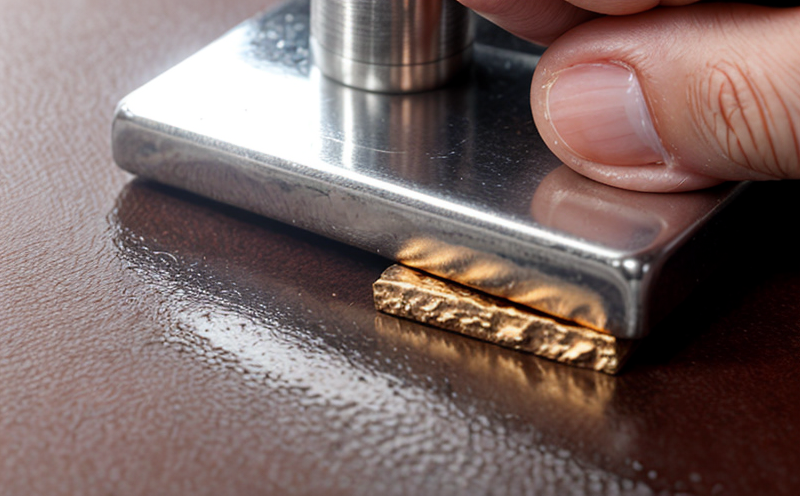DIN 17012 Atomic Absorption of Base Metal Alloys Testing
The DIN 17012 standard is a widely recognized method in the field of mineral testing, particularly for base metal alloys. This atomic absorption spectroscopy (AAS) technique ensures accurate and precise measurement of trace elements within these alloy systems. The method is particularly useful for quality managers and compliance officers who need to ensure that their products meet stringent international standards.
Base metals such as copper, zinc, nickel, lead, and others are essential in various industries including mining, metallurgy, and manufacturing. Accurate analysis of these elements helps maintain product integrity and meets regulatory requirements. The DIN 17012 standard provides a robust framework for testing, which is critical for R&D engineers working on alloy development.
The process begins with the careful preparation of the sample. This involves mechanical or chemical digestion to convert the solid material into a solution suitable for analysis. The prepared solution is then introduced into an atomic absorption spectrometer where it interacts with light at specific wavelengths corresponding to each element being analyzed.
Atomic Absorption Spectroscopy (AAS) operates on the principle that elements in their gaseous state absorb light of certain wavelengths. By measuring this absorption, the concentration of each element can be determined. This method is particularly sensitive and provides accurate results for trace elements down to parts per million levels.
The DIN 17012 standard specifies precise operating conditions for the spectrometer, including flame or graphite furnace atomization techniques depending on the element being measured. The use of these specific methods ensures that the results are consistent with international standards and can be compared across different laboratories.
Quality assurance is a crucial aspect of this testing method. Compliance officers rely on DIN 17012 to ensure their products meet regulatory requirements. This includes compliance with ISO, ASTM, EN, IEC, and other relevant standards. The precise nature of AAS allows for the identification of even minute amounts of impurities or alloying elements, which is essential for maintaining product purity.
For R&D engineers, DIN 17012 provides a reliable method to develop new alloys with specific properties. By understanding the elemental composition precisely, they can optimize formulations and ensure that the final products meet all specified requirements. This testing also supports procurement activities by ensuring suppliers provide materials that adhere strictly to specifications.
Testing according to DIN 17012 is not only about meeting standards but also about enhancing product quality and reliability. The method allows for detailed analysis, which can be used in research and development efforts to improve existing products or develop new ones tailored to market needs.
Benefits
- Accurate and precise measurement of trace elements within base metal alloys,
- Ensures compliance with international standards such as DIN 17012, ISO, ASTM, EN, IEC,
- Supports quality assurance in production processes,
- Aids in the development and optimization of new alloy formulations,
- Improves product reliability by identifying impurities or alloying elements early in the process,
- Facilitates consistent results across different laboratories,
- Enables detailed analysis for both quality managers and R&D engineers,
- Safeguards against non-compliance issues with regulatory bodies.
Eurolab Advantages
At Eurolab, we pride ourselves on offering comprehensive testing services that meet the highest international standards. Our expertise in DIN 17012 atomic absorption spectroscopy is matched by our commitment to quality and precision.
We have state-of-the-art equipment specifically calibrated for this method, ensuring accurate results every time. Our team of experienced chemists and engineers are trained to follow the strict protocols outlined in DIN 17012, guaranteeing reliable outcomes that can be trusted across various applications.
Our laboratories are equipped with advanced spectrometers capable of detecting trace elements down to parts per million levels, making us uniquely positioned to provide detailed analyses. This precision is crucial for ensuring product integrity and meeting regulatory requirements.
We offer a range of services from sample preparation through to final analysis, providing a complete package that simplifies the testing process for our clients. Our comprehensive approach ensures that every step of the process adheres strictly to DIN 17012 standards.
Competitive Advantage and Market Impact
The ability to conduct accurate and reliable DIN 17012 atomic absorption spectroscopy testing provides a significant competitive advantage in the mining sector. By ensuring that our clients’ products meet international standards, we help them stay ahead of regulatory changes and market demands.
Our precise testing capabilities enable us to deliver detailed reports that can be used to optimize product formulations, identify impurities early on, and ensure compliance with all relevant standards. This not only enhances the quality of our client’s products but also helps in maintaining a positive reputation within their industry.
The detailed analysis provided by DIN 17012 ensures that our clients are fully aware of any issues that may arise during production or supply chain processes. By addressing these problems early, we help prevent costly mistakes and ensure smooth operations.
Our commitment to maintaining high standards in every aspect of our testing services contributes significantly to the market impact of Eurolab. We consistently deliver reliable results that can be trusted by quality managers, compliance officers, R&D engineers, and procurement specialists alike. This trust translates into long-term partnerships with our clients who recognize the value we bring to their operations.





